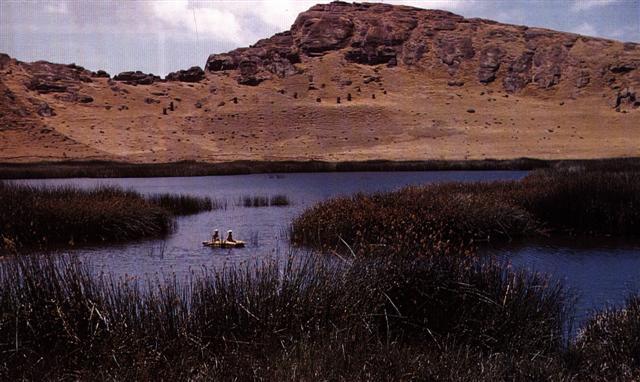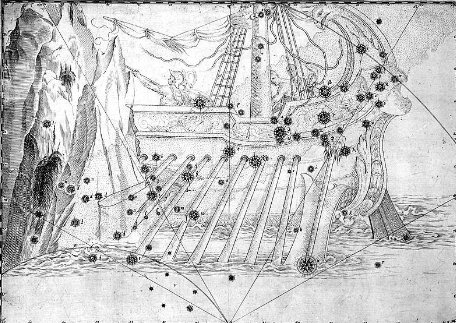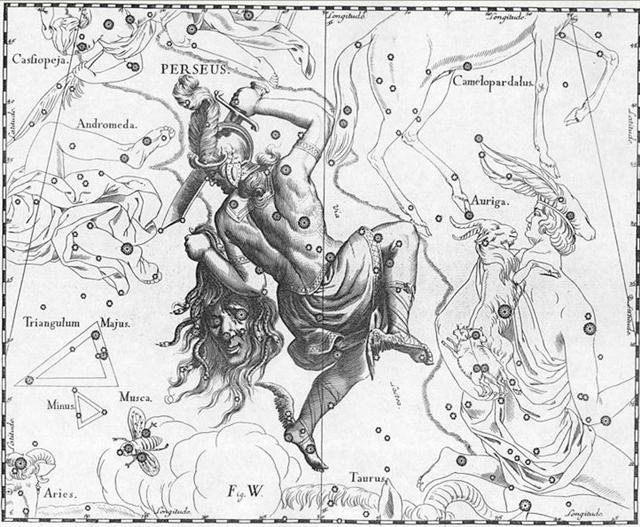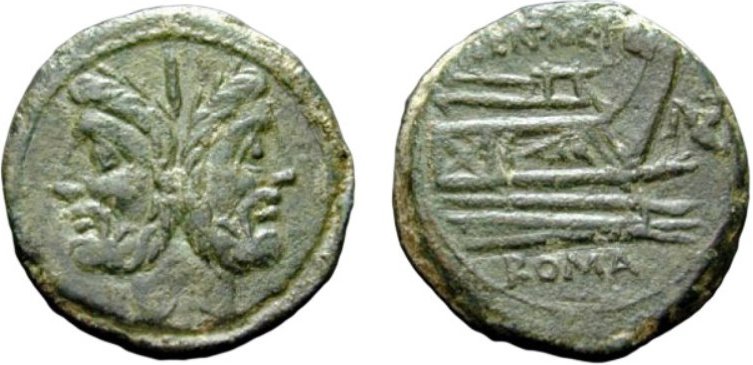Once upon a time the number of days in January had been measured
out as 29:
The Julian calendar introduced in 46 B.C. by Caesar changed the earlier 355 day long regular calendar by increasing the length of 7 of the months:
| Martius |
31 |
31 |
- |
| Aprilis |
29 |
30 |
+1 |
| Maius |
31 |
31 |
- |
| Iunius |
29 |
30 |
+1 |
| Quintilis |
31 |
31 |
- |
| Sextilis |
29 |
31 |
+2 |
| Sum |
180 |
184 |
+4 |
| September |
29 |
30 |
+1 |
| October |
31 |
31 |
- |
| Sum |
240 |
245 |
+5 |
| November |
29 |
30 |
+1 |
| December |
29 |
31 |
+2 |
| Ianuarius |
29 |
31 |
+2 |
| Februarius |
28 |
28 |
- |
| Sum |
355 |
365 |
+10 |
The ordinary year in the previous Roman calendar consisted of 12 months, for a total of 355 days. In addition, a 27-day intercalary month, the Mensis Intercalaris, was sometimes inserted between February and March. This intercalary month was formed by inserting 22 days after the first 23 or 24 days of February; the last five days of February, which counted down toward the start of March, became the last five days of Intercalaris. The net effect was to add 22 or 23 days to the year, forming an intercalary year of 377 or 378 days. (Wikipedia)
|
Rano Raraku, where the moai statues were 'born',
could therefore in a way be put in parallel with the last day of
Ianuarius (→ Janus).
|
29 ko
te rano a raraku.
Rano.
Volcano; crater and lake of a volcano;
i-agataiahi i-hopu-ai i te rano,
yesterday I bathed in the lake of the
volcano. Vanaga. In Nuclear Polynesian the
sense is specialized, the waters of birth
being recorded in Samoa and Futuna, and in
every case the word refers to the rinsing
off of sea water. To wash away the salt
water is not only for appearance sake in the
tropical Pacific. The sea has a high degree
of salinity and the salt crystals are not
only the clearly visible signs of an unkempt
habit when they glisten upon the brown
skins, but they are uncomfortable as well.
This use stamps upon lanu a sense in
which the fact that it is fresh water is
more prominent than the water sense.
Churchill 2.
Rara.
Mgv.: a branch of a tree. Ta.: rara,
id. Mq.: rara, small branches. Sa.:
lala, id. Ma.: rara, id.
Churchill.
"The famous mountain of sculptors'
workshops is given the name 'the crater
(lake)' and the personal addition Raraku -
'to scratch (earth)' - wordplay for the
unearthing of the quarries?..." (The
Eighth Island)
 |
... In January 29 (→ Mercury) the star Betelgeuze culminated (at
21h). The 3 'stones' of Tau-toru (Mintaka, Alnilam,
Alnitak) culminated in January 24, 25, respectively 26 ...
|
December
solstice |
|
8 |
South Dipper |
φ Sagittarii
(?) |
Unicorn |
(284.0) |
Dec 30 (364) |
|
9 |
Ox / Herd
Boy |
β
Capricornii (Dabih) |
Buffalo |
(308.0) |
Jan 23 (388) |
|
10 |
Girl |
ε Aquarii
(Albali) |
Bat |
(314.8) |
Jan 29
(394) |
|
11 |
Emptiness |
β Aquarii
(Sadalsud) |
Rat |
(325.9) |
Feb 9 (405) |
|
12 |
Rooftop |
α Aquarii
(Sadalmelik) |
Swallow |
(334.6) |
Feb 18 (414) |
|
13 |
House |
α Pegasi
(Markab) |
Pig |
(349.5) |
Mar 5 (429) |
|
March
equinox |
| Te ragi |
tagata - ragi |
kua hakagana - ki te
maro |
|
Ana.
1. Cave. 2. If. 3. Verbal prefix:
he-ra'e ana-unu au i te raau, first I drank
the medicine. Vanaga. 1. Cave, grotto, hole in the rock.
2. In order that, if. 3. Particle (na 5); garo
atu ana, formerly; mee koe ana te ariki, the
Lord be with thee. PS Sa.: na, an intensive
postpositive particle. Anake, unique. T Pau.:
anake, unique, to be alone. Mgv.: anake,
alone, single, only, solely. Mq.: anake, anaé,
id. Ta.: anae, all, each, alone, unique.
Anakena, July. Ananake, common, together,
entire, entirely, at once, all, general, unanimous,
universal, without distinction, whole, a company;
piri mai te tagata ananake, public; kite aro o te
mautagata ananake, public; mea ananake,
impartial; koona ananake, everywhere. Churchill.
Splendor; a name applied in the Society Islands to ten
conspicious stars which served as pillars of the sky.
Ana appears to be related to the Tuamotuan
ngana-ia, 'the heavens'. Henry translates ana
as aster, star. The Tahitian conception of the
sky as resting on ten star pillars is unique and is
doubtless connected with their cosmos of ten heavens.
The Hawaiians placed a pillar (kukulu) at the
four corners of the earth after Egyptian fashion; while
the Maori and Moriori considered a single great central
pillar as sufficient to hold up the heavens. It may be
recalled that the Moriori Sky-propper built up a single
pillar by placing ten posts one on top of the other.
Makemson. |
 |
 |
 |
|
Cb5-1 (95) |
Cb5-2 (8 *
12) |
Cb5-3 (123 -
26) |
|
CLOSE TO THE FULL
MOON: |
|
8h (121.7)
χ
Gemini (121.0),
NAOS
= ζ Puppis
(121.3) |
ρ Puppis (122.0),
HEAP
OF FUEL = μ Cancri
(122.1),
ζ Monocerotis (122.3),
ψ Cancri (122.6),
REGOR
(Roger backwards) = γ Velorum
(122.7) |
TEGMINE = ζ Cancri
(123.3) |
|
Zayin
(also spelled Zain or Zayn or simply
Zay) is the seventh letter of many Semitic abjads
... It represents the sound [z].
The Phoenician letter appears to be named after a sword
or other weapon. (In Biblical Hebrew, 'Zayin'
means sword, and the verb 'Lezayen' means to arm.
In modern Hebrew, 'zayin' means penis and 'lezayen'
is a vulgar term which generally means to perform sexual
intercourse and is used in a similar fashion to the
English word fuck, although the older meaning survives
in 'maavak mezuyan' (armed struggle) and 'beton
mezuyan' (armed, i.e., reinforced concrete). The
Proto-Sinaitic glyph according to Brian Colless may have
been called ziqq, based on a hieroglyph depicting
a 'manacle'.
 |
|
July 20 |
21 (202) |
22 / 7 → π |
|
'June 23 |
ST JOHN'S
DAY (175) |
25 |
|
he ea.a Ira.he iri he oho ki runga anake.i
te angahuru o te raa o te maro i iri ai.he tuu ki
te manavai hee rarama.
(Ira
got up. They all climbed to the top of the hill.
They climbed up
on the tenth day of the month of June ('Maro').
They reached the side crater (te manavai) and looked
around carefully.) |
|
"June 9 |
TE MARO 10 (161) |
11 |
|
... The month, which
takes its name from Juppiter the oak-god, begins on June
10th and ends of July 7th. Midway comes St. John's Day,
June 24th, the day on which the oak-king was
sacrificially burned alive. The Celtic year was divided
into two halves with the second half beginning in July,
apparently after a seven-day wake, or funeral feast, in
the oak-king's honour
...
 |
|
CLOSE TO THE
SUN: |
|
Jan 19 |
20 |
21 |
| tagata mau matagi |
ihe toga maa |
ura
hia |
tagata maú kihikihi
erua |
 |
 |
 |
 |
|
Cb5-4 (392 + 98 = 490) |
Cb5-5 |
Cb5-6 (100) |
Cb5-7 |
|
CLOSE TO THE FULL
MOON: |
|
AL TARF
(The End) =
β
Cancri
(124.3)
RAS
ALGETHI (α Herculis) |
χ
Cancri (125.2),
BRIGHT FIRE =
λ Cancri
(125.4)
*84.0 = *125.4 - *41.4 |
AVIOR =
ε
Carinae
(126.4),
φ
Cancri (126.8)
*85.0 = *126.4 - *41.4 |
ο Ursa Majoris (127.4)
*86.0 = *127.4 - *41.4 |
|
July 23 |
24 |
25 |
26 |
|
'June 26 (177 = 6 * 29½) |
27 |
28 |
29 |
|
"June 12 |
13 |
14 (165) |
15 |
|
CLOSE TO THE
SUN: |
|
Jan 22 |
23 |
24 |
25 |
|
GREDI
(Goat) =
α
Capricorni
(307.2),
σ
Capricorni (307.5),
ALSHAT (The Sheep) =
ν
Capricorni
(307.9) |
Al Sa’d al Dhabih-20 (Lucky One of the Slaughterers) /
Ox / Herd Boy-9
(Buffalo)
DABIH = β Capricorni
(308.0),
κ
Sagittarii (308.1), SADIR (Hen's Breast) =
γ
Cygni (308.4),
PEACOCK = α Pavonis (308.7) |
OKUL
= π Capricorni
(309.6),
BOS =
ρ Capricorni
(309.9)
ARNEB (α
Leporis)
|
ο Capricorni (310.2), θ Cephei (310.5)
HEKA (λ
Orionis)
|
MINTAKA (δ Orionis) |
ALNILAM (ε Orionis) |
 |
| te hoko huki |
kua kake te manu
puoko erua |
E nuku mata |
te kihikihi o te ariki
- te hokohuki |
te hau tea |
 |
 |
 |
 |
 |
|
Cb5-8 |
Cb5-9 |
Cb5-10 (104) |
Cb5-11 |
Cb5-12 |
|
CLOSE TO THE FULL
MOON: |
|
Āshleshā-9 (Embrace) /
Willow-24 (Stag)
π¹ Ursa Majoris,
δ Hydrae (129.6),
AL MINHAR AL SHUJĀ = σ Hydrae, MUSEIDA = π² Ursae
Majoris
(129.9)
RAS
ALHAGUE (α Ophiuchi) |
Al Nathrah-6 (Gap)
BEEHIVE (Exhalation of Piled-up Corpses) = ε Cancri, η Pyxidis (130.4),
XESTUS = ο Velorum
(130.5), ζ Pyxidis (130.7),
ASCELLUS BOREALIS = γ Cancri, β Pyxidis (130.9)
*89.0 = *130.4 - *41.4 |
Extended Net-26a (Ox) /
Arkū-sha-nangaru-sha-shūtu-12 (Southeast Star in the
Crab)
η
Hydrae (131.0),
ASCELLUS AUSTRALIS =
δ
Cancri
(131.4),
KOO SHE (Bow and Arrow)
= δ Velorum
(131.6),
α
Pyxidis (131.8),
ε
Hydrae
(131.9)
*90.0 = *131.4 - *41.4 |
ι Cancri (132.0), ρ Hydrae (132.4)
*91.0 = *132.4 - *41.4 |
γ Pyxidis (133.6) |

... A man had a daughter who
possessed a wonderful bow and arrow, with which she was
able to bring down everything she wanted. But she was
lazy and was constantly sleeping. At this her father was
angry and said: 'Do not be always sleeping, but take thy
bow and shoot at the navel of the ocean, so that we may
get fire.' The navel of the ocean was a vast whirlpool
in which sticks for making fire by friction were
drifting about. At that time men were still without
fire. Now the maiden seized her bow, shot into the navel
of the ocean, and the material for fire-rubbing sprang
ashore. Then the old man was glad. He kindled a large
fire, and as he wanted to keep it to himself, he built a
house with a door which snapped up and down like jaws
and killed everybody that wanted to get in. But the
people knew that he was in possession of fire, and the
stag determined to steal it for them. He took resinous
wood, split it and stuck the splinters in his hair. Then
he lashed two boats together, covered them with planks,
danced and sang on them, and so he came to the old man's
house. He sang: 'O, I go and will fetch the fire.' The
old man's daughter heard him singing, and said to her
father: 'O, let the stranger come into the house; he
sings and dances so beautifully.' The stag landed and
drew near the door, singing and dancing, and at the same
time sprang to the door and made as if he wanted to
enter the house. Then the door snapped to, without
however touching him. But while it was again opening, he
sprang quickly into the house. Here he seated himself at
the fire, as if he wanted to dry himself, and continued
singing. At the same time he let his head bend forward
over the fire, so that he became quite sooty, and at
last the splinters in his hair took fire. Then he sprang
out, ran off and brought the fire to the people ... |
|
CLOSE TO THE
SUN: |
|
Jan 26 |
27 |
28 |
29 |
30 |
|
ROTANEV = β Delphini,
ι Delphini (312.3), τ Capricorni (312.6), κ Delphini
(312.7), SVALOCIN = α
Delphini, υ Capricorni, υ
Pavonis (312.8)
PHAKT (α Columbae)
|
μ², μ¹ Oct. (313.2),
DENEB CYGNI (Tail of the Swan) = α Cygni
(313.5), β Pavonis (313.6), δ Delphini (313.8) |
Al Sa’d al Bula'-21 (Good Fortune of the Swallower) /
Dhanishta-24 (Most Famous) /
Girl-10 (Bat)
YUE (Battle-Axe) = ψ Capricorni
(314.3),
GIENAH CYGNI = ε Cygni,
η Cephei (314.5), γ Delphini (314.6), σ Pavonis (314.7),
ALBALI = ε Aquarii
(314.8) |
BATEN ALGIEDI
(Belly of the Goat) =
ω
Capricorni
(315.8)
BETELGEUZE (α Orionis)
|
μ
Aquarii (316.0) |
|
ALNILAK (ζ Orionis)
|
| te moa |
te maitaki |
te henua |
e
gagata tu - ki te huaga |
koia ra kua mau ki
toona mea |
67 |
 |
 |
 |
 |
 |
 |
|
Cb5-13
(107) |
(392 +
108 = 500) |
Cb5-15 |
Cb5-16 |
Cb5-17 |
Cb5-18 |
|
CLOSE TO THE FULL
MOON: |
|
ζ
Hydrae (134.1),
ρ
Cancri (134.2),
ζ
Oct.
(134.3), ο Cancri (134.6), δ Pyxidis (134.9) |
ACUBENS
= α Cancri,
TALITHA BOREALIS = ι Ursae Majoris
(135.0), σ Cancri (135.2), ρ Ursa Majoris (135.6) |
ν Cancri (136.0),
TALITHA AUSTRALIS = κ Ursae Majoris
(136.1), ω Hydrae (136.8) |
9h (137.0)
σ¹ Ursa Majoris (137.0), κ Cancri (137.3), τ
Cancri (137.4),
ALSUHAIL (al Wazn, of the Weight) = λ Velorum
(137.5), σ² Ursa Majoris (137.6), τ Ursa Majoris
(137.7), ξ Cancri (137.8)
*96.0 = *137.4 - *41.4 |
κ Pyxidis (138.0), ε Pyxidis (138.5) |
π
Cancri (139.2),
MIAPLACIDUS =
β
Carinae
(139.3),
TUREIS (Little Shield) =
ι
Carinae
(139.8) |
|
CLOSE TO THE
SUN: |
|
Jan 31
(396) |
Febr 1 |
2 |
3 |
4 (400) |
5 (36) |
| te hokohuki -
ma te maro |
te hokohuki ma
te maro |
ka ke te manu
ki te maro |
|
Hoko. 1. To jump;
to rock or swing in rhythm with
the chants in festivals, as was the ancient
custom; an ancient dance. He to'o mai
e te hoa manu i te mamari ki toona rima, he
ma'u, he hoko, the 'bird master' receives
the egg in his hand and carries it, dancing. 2.
Number prefix: 'in a group of...':
hokotahi,
alone; hokorua, in a group of two (also companion, e
hakarere te kai mo toou hokorua, leave some
food for my companion); hakatoru, in a
group of three, etc.; hokohía, in a group
of how many? Hokohía ana oho koe ki te rano?
With how many people will you go to the volcano?
Vanaga. 1. To traffic, to trade, to buy, to
ransom (hoò); hoòa te kaiga, to
buy land. 2. To sport, to play. Churchill. Move
the body to and fro with the rythm of a song.
Barthel.
Huki 1. Pole attached to
the poop from which the
fishing-net is suspended: huki kupega. 2. Digging stick. 3. To
set vertically, to stand (vt.). 4.
Huki á te mahina, said of the new moon when
both its horns have become visible. Vanaga. 1.
To post up, to publish. 2. To cut the throat (uki).
Mq.: Small sticks which close up the ridge of a
house. Ha.: hui, the small uniting sticks
in a thatched house. Churchill. Standing
upright. Barthel. M. Spit for roasting. Te
Huki, a constellation. Makemson. Hukihuki.
1. Colic. 2. To transpierce, a pricking. 3. To
sink to the bottom. Churchill. |
 |
 |
 |
|
Cb8-9 (572 = 504 + 68) |
Cb8-10 (392 + 181 = 573) |
Cb8-11 |
|
CLOSE TO THE
FULL MOON: |
|
ε Centauri (206.3), κ Oct. (206.4)
*165.0 = *206.4 - *41.4 |
no star listed (207) |
τ
Bootis (208.2),
BENETNASH
(Leader of the Daughters of the Bier) =
η
Ursae Majoris
(208.5),
ν
Centauri (208.7),
μ
Centauri,
υ
Bootis (208.8) |
 |
|
Oct 13 |
14 |
15 (288) |
|
... The position of Nunki (the Star of
the Proclamation of the Sea) was in right
ascension day *288 (as counted from 0h at the
time of rongorongo)
...
... The
Julian calendar day Thursday, 4 October 1582 was
followed by the first day of the Gregorian
calendar, Friday, 15 October 1582 (the cycle of
weekdays was not affected)
...
... At the
time of
Bharani the Sun
would have reached Antares in "October 15 (288),
and 8 * 36 = 288 (= 432 - 144)
... |
|
'Sept 16 |
17 (20 * 13) |
18 (9 * 29) |
|
HORA NUI 2 |
3 (2 ' 123) |
4 |
|
... Hotu's
canoe sailed from Maori to Te Pito O
Te Kainga. It sailed on the second day of
September (hora nui)
... (E:74) |
|
CLOSE TO THE
SUN: |
|
April 13 → 14 * 29½ |
14 (104 = 2 * 52) |
15 |
|
... When it was evident that the years lay ready
to burst into life, everyone took hold of them,
so that once more would start forth - once again
- another (period of) fifty-two years. Then (the
two cycles) might proceed to reach one hundred
and four years. It was called 'One Age' when
twice they had made the round, when twice the
times of binding the years had come
together. Behold what was done when the years
were bound - when was reached the time when they
were to draw the new fire, when now its count
was accomplished. First they put out fires
everywhere in the country round. And the
statues, hewn in either wood or stone, kept in
each man's home and regarded as gods, were all
cast into the water. Also (were) these (cast
away) - the pestles and the (three) hearth
stones (upon which the cooking pots rested); and
everywhere there was much sweeping - there was
sweeping very clear. Rubbish was thrown out;
none lay in any of the houses...
...
Lat., jugum,
a yoke; jugo,
bind up, tie together; jungo,
bind, join, unite ... A singular coincidence of
application, if it has no nearer connection, by
the Polynesian and the Latin of this word to
similar purposes, occurs in the huhui
and hui-tarawa
of the former and
jugulæ
of the latter. In Hawaiian huhui
designates a constellation generally, but
especially that of the Pleiades; in Tahitian
hui-tarawa,
lit. the transverse or horizontal cluster,
designates the stars generally called Orion's
belt, and in Latin jugulæ
represents the very same stars in the
constellation Orion ... |
|
ACHERNAR
(End of the River) =
α
Eridani
(23.3),
χ
Andromedae (23.6),
τ
Andromedae (23.9) |
ALSEIPH
(Scimitar) =
φ
Persei
(24.5),
τ
Ceti (24.7) |
no star listed (25) |
 |
We can now guess why the creators of Manuscript E
saw it necessary to cross over the pair of Makoi
stations which corresponded to Februarius 1 and 2 -
viz. these days ought to be relocated to page E:40 in order
to reflect the ancient order.


|






















